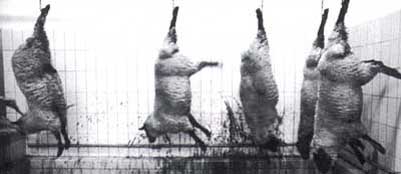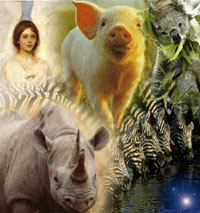Slaughterhouse
by Gail A Eisnitz
Prometheus Books, New York, 1997
310 pp; $29.95 hc

Reviewed by Alex Hershaft, PhD,
President, FARM

In the midst of our high-tech, ostentatious, hedonistic lifestyle, among the dazzling monuments to history, art, religion, and commerce, there are the 'black boxes.' These are the biomedical research laboratories, factory farms, and slaughterhouses - faceless compounds where society conducts its dirty business of abusing and killing innocent, feeling beings.
These are our Dachaus, our Buchenwalds, our Birkenaus. Like the good German burghers, we have a fair idea of what goes on there, but we don't want any reality checks. We rationalize that the killing has to be done and that it's done humanely. We fear that the truth would offend our sensibilities and perhaps force us to do something. It may even change our life.
Slaughterhouse by Gail Eisnitz of the Humane Farming Association is a gut-wrenching, chilling, yet carefully documented, expose of unspeakable torture and death in America's slaughterhouses. It explodes their popular image of obscure factories that turn dumb 'livestock' into sterile, cellophane-wrapped 'food' in the meat display case. The testimony of dozens of slaughterhouse workers and USDA inspectors pulls the curtain on abominable hellholes, where the last minutes of innocent, feeling, intelligent horses, cows, calves, pigs, and chickens are turned into interminable agony. And, yes, the book may well change your life. Here are some sample quotes (warning! extremely offensive material follows).
The agony starts when the animals are hauled over long distances under extreme crowding and harsh temperatures. Here is an account from a worker assigned to unloading pigs: "In the winter, some hogs come in all froze to the sides of the trucks. They tie a chain around them and jerk them off the walls of the truck, leave a chunk of hide and flesh behind. They might have a little bit of life left in them, but workers just throw them on the piles of dead ones. They'll die sooner or later."
Once at the slaughterhouse, some animals are too injured to walk and others simply refuse to go quietly to their deaths. This is how the workers deal with it: "The preferred method of handling a cripple is to beat him to death with a lead pipe before he gets into the chute... If you get a hog in a chute that's had the shit prodded out of him, and has a heart attack or refuses to move, you take a meat hook and hook it into his bunghole (anus)...and a lot of times the meat hook rips out of the bunghole. I've seen thighs completely ripped open. I've also seen intestines come out."
And here is what awaits the animals on the kill floor. First, the testimony of a horse slaughterhouse worker: "You move so fast you don't have time to wait till a horse bleeds out. You skin him as he bleeds. Sometimes a horse's nose is down in the blood, blowing bubbles, and he suffocates."
Then another worker, on cow slaughter: "A lot of times the skinner finds a cow is still conscious when he slices the side of its head and it starts kicking wildly. If that happens, ... the skinner shoves a knife into the back of its head to cut the spinal cord." (This paralyzes the animal, but doesn't stop the pain of being skinned alive.) And still another, on calf slaughter: "To get done with them faster, we'd put eight or nine of them in the knocking box at a time... You start shooting, the calves are jumping, they're all piling up on top of each other. You don't know which ones got shot and which didn't... They're hung anyway, and down the line they go, wriggling and yelling"(to be slaughtered while fully conscious).
And on pig slaughter: "If the hog is conscious, ... it takes a long time for him to bleed out. These hogs get up to the scalding tank, hit the water, and start kicking and screaming... There's a rotating arm that pushes them under. No chance for them to get out. I am not sure if they burn to death before they drown, but it takes them a couple of minutes to stop thrashing."
The work takes a major emotional toll on the workers. Here's one worker's account: "I've taken out my job pressure and frustration on the animals, on my wife, ... and on myself, with heavy drinking." Then it gets a lot worse: "... with an animal who pisses you off, you don't just kill it. You ... blow the windpipe, make it drown in its own blood, split its nose... I would cut its eye out... and this hog would just scream. One time I ... sliced off the end of a hog's nose. The hog went crazy, so I took a handful of salt brine and ground it into his nose. Now that hog really went nuts..."
Safety is a major problem for workers who operate sharp instruments standing on a floor slippery with blood and gore, surrounded by conscious animals kicking for their lives, and pressed by a speeding slaughter line. Indeed, 36 percent incur serious injuries, making their work the most hazardous in America. Workers who are disabled and those who complain about working conditions are fired and frequently replaced by undocumented aliens. A few years ago, 25 workers were burned to death in a chicken slaughterhouse fire in Hamlet, NC, because management had locked the safety doors to prevent theft.
Here is a worker's account: "The conditions are very dangerous, and workers aren't well trained for the machinery. One machine has a whirring blade that catches people in it. Workers lose fingers. One woman's breast got caught in it and was torn off. Another's shirt got caught and her face was dragged into it."
Although Slaughterhouse focuses on animal cruelty and worker safety, it also addresses the issues of consumer health, including the failure of the federal inspection system. There is a poignant testimony from the mother of a child who ate a hamburger contaminated with E. coli: "After Brianne's second emergency surgery, surgeons left her open from her sternum to her pubic area to allow her swollen organs room to expand and prevent them from ripping her skin... Her heart ... bled from every pore. The toxins shut down Brianne's liver and pancreas. An insulin pump was started. Several times her skin turned black for weeks. She had a brain swell that the neurologists could not treat... They told us that Brianne was essentially brain-dead."
Slaughterhouse has some problems. In an attempt to reflect the timeline of the investigation, the presentation suffers from poor organization and considerable redundancy. But that's a bit like criticizing the testimony on my Holocaust experiences because of my Polish accent. The major problem is not with the content of the book, but with the publisher's cover design. The title and the headless carcasses pictured on the dust jacket effectively ensure that the book will not be read widely and that the shocking testimony inside will not get out to the consuming public.
And that's a pity. Because the countless animals whose agony the book documents so graphically deserve to have their story told. And because Slaughterhouse is the most powerful argument for meatless eating that I have ever read. Eisnitz' closing comment "Now you know, and you can help end these atrocities" should be fair warning. After nearly 25 years of work on farm animal issues, including leading several slaughterhouse demonstrations, I was deeply affected. Indeed, reading Slaughterhouse has changed my life.
* * * Slaughterhouse is available from FARM (PO Box 30654, Bethesda, MD 20824), Humane Farming Association (PO Box 3577, San Rafael, CA 94912), and most bookstores. People who would like to help get this information to the general public should contact FARM and HFA.
HOME
ALF FAQ
British Beef
Finger-Lickin' Cruel
ANIMAL RIGHTS FAQ
British Meat and BSE
Human BSE Foundation
49 Reasons To Be A Vegetarian
British Meat: the recipe for cancer
British meat crisis: has BSE spread to sheep?
